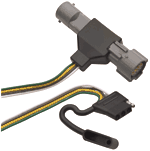|
|
|
|
|
This the 7 pin plug for a hook-up to charge a battery off your alternator while driving. (Also see the isolators below) |
|||
|
|
|||
|
Note: Make sure you install a 30 amp circuit breaker after the isolator on the wire going back to # 4 on your plug |
|
||
|
This is a common 6 pin trailer plug.
|
|||
|
White (GD) = Ground Brown (TM) = Parking lights Yellow (LT) = Left turn signal Red (S) = Electric brakes / stop Green (RT) = Right turn signal Blue (A) = Auxiliary
|
|||
|
This is the very common 4 pin hook-up
|
|||
|
|
|||
|
|
|||
|
Harness Adaptors. |
|||
  
|
There are also many different adaptors to use they can turn a 7 pin plug into a 6 pin round or 4 pin flat, Special ones so that you do not need to cut your harness and many more, These tend to be cheap and work great |
||
|
|
|||
|
|
Isolators and Solenoids |
||
|
Isolators... |
|||
|
When you need to hook an extra battery to your wiring for uses such as recharging your camper battery, it is important to install an isolator. To understand the problem of multi-battery drain, and how an isolator prevents it, think of electricity as water. Electrical currant is equal to the flow of water, and voltage is equal to the pressure. The alternator pumps the current (water) into the batteries (water tank). The current then flows through the wires (pipes) to the accessories. If you think of batteries as water tanks you can see that if a fully charged battery is connected to a discharged battery, the voltage will force its current into the dead battery until they reach a common level. The discharged battery will always rob from the charged battery. If left this way, and allowed to drain, it can leave you with dead batteries and an engine that won't start (and you know it will be raining..)
Solenoids... Many people try to tackle this problem with solenoids. A solenoid is basically a switch that disconnects the two batteries from one and another. With a solenoid there is no longer any battery drain, however.. once the solenoid reconnects the two batteries, the dead battery will again drain the charged one. Now if that is all that happened, it would not be a big concern, But! the sudden violent transfer of energy from one battery to the other can shorten battery life, overheat wires and connections, and worst of all, this can cause fires... This should really not be used as a method of disconnecting batteries, this is a job meant for an isolator.. Could you imagine using jumper cables to start a car made out of 8 gauge wire 20 feet long??
The Solution... To eliminate battery drain an isolator works as a check valve between the two batteries, preventing current from flowing from one to another. Each battery is separated and acts as a separate power source. No matter how dead one battery becomes, it will never drain from the other. The isolator which now has the alternator now feeding it instead of the battery, acts as a voltage regulator to feed current to each battery based on its setting. Any back flow is eliminated by the use of diodes as "check valves"
Last but not least... I also will add this tip, buy a nice big tube of "dialectic grease". Use that to fill the inside of the vehicle plug before you screw it back together.. and then do the same for the trailer cord end.. and also between the plugs where you plug them together... This will stop almost all corrosion which is the leading cause of light failure on trailers... I do not recommend silicon, mainly because it is messy and hard to clean up, it does not prevent corrosion (and it will get past it) and it also makes it much harder to work on later..
|
|||
This page created & maintained by Lee
last edited 02-18-2002